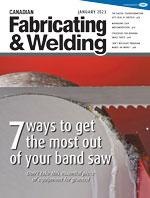Product Manager, Press Brake and Bending Automation
- FMA
- The Fabricator
- FABTECH
- Canadian Metalworking
Strategies for bending small parts
Safety and machine size matter when managing complex bends
- By Marcel Fiedler
- February 17, 2023
- Article
- Fabricating

Ganging parts together using microjoints can be a great way to speed up the production of small parts, whether you are using a large or small press brake. If your bend lines are parallel, it might be possible to bend five to eight parts together. In this example we see two parts being bent at the same time. Image: Bystronic
Complex small parts can get tricky to bend. Because you are working with a very small surface area, there is little room for error, especially when a number of bends are in play. Issues such as bend sequencing and how the operator holds the part must be carefully considered.
Even more fundamentally, however, is the equipment being tasked with this work. Is it the most efficient and effective tool for your application?
Right-sizing Your Machine
About 80 per cent of parts being bent on larger press brakes, such as the 150-ton, 10-ft. press brakes commonly found on the shop floor, could be bent on a smaller press brake. A 40-ton or 80-ton brake usually is sufficient force for 80 per cent of the work. Look at your part mix and consider what size machine truly makes sense for your operation. Will a second, smaller press brake free up the bigger brake to handle large parts or jobs that require a quick turnaround?
A small brake allows you to take advantage of the greater acceleration available on those machines because you have less mass that you are moving to achieve the bends. These smaller hybrid or electric brakes have become so fast that they are producing 20 per cent to 30 per cent more parts compared to a larger brake. Sizing your brake properly for the work you do can make a big difference.
Beyond the time savings and power savings that come from using a smaller hybrid or electric machine, gauging is made simpler as well.
The gauges on smaller machines tend to have finer contours designed for gauging points for smaller parts. A press brake with a larger backgauge will include a larger surface area for contact points, especially when bending 10-ft.-long parts. But when it comes to smaller parts, having a small recess on the backgauge, for instance, can be a huge help because you have another gauging point for the operator to find the right spot to bend. This gives you more flexibility.
The ergonomics of a small brake also can be helpful for operators because usually they can sit at the machine and are within reach of stacked blanks and a box to place finished parts. This can be a big help, especially when handling very repetitive jobs.
These machines also tend to be mobile and can be moved as necessary to meet the needs of your business.
Safety First
Larger parts are easier to handle because of their larger surface areas. When dealing with smaller parts, it becomes very important to consider whether the safety system on your press brake is robust enough for the work being processed.
Safety systems are obviously mandatory on press brakes, but it’s important to ensure the one you are using is smart enough to recognize what is considered safe such that the operator is far enough away from the bend line, and if the operator isn’t far enough away, the tooling comes to a stop. Smaller brakes tend to be designed with this in mind, often with a laser beam detection system at the end of the ram to monitor this close work.
Handling particularly small parts can be a challenge. A number of inexpensive tools such as gauging aids can help. A gauging aid is a magnetized gauge that sits against the end of the bottom tool and serves as another gauging point at the front of the machine to assist the operator in lining up a part properly. This can be helpful when dealing with smaller parts.
Automation is another way to help manage smaller parts in a safe manner. Not only can a robot work closely to the bend line without risking serious injury, it also can repetitively bend thousands of the same part without feeling fatigued, which is another danger with repetitive small jobs.
Tool Setup and Bend Sequencing
When working with small parts, it’s critical to set up your tooling as precisely as possible to manage small contours and flanges. The right software can help you create the ideal tool setup based on the tools you already have in your library.
Usually, bending larger panels is straightforward in terms of bend steps. But small parts with eight or nine bends can become tricky. Software can help with this process. If a bend sequence has multiple tool setups, it can tell the operator on which station to perform the next bend. Many software packages have visual aids to assist in this sequencing, which can be very important if your operators have less work experience or are more visual learners.
Nowadays, precision-ground tooling comes in many different segments, which makes it easier to bend smaller parts because you can buy the segments exactly for the length of the bend lines. This becomes extremely important when bending parts with perpendicular bend lines, where you would otherwise risk a collision with the tool.
With a smaller brake, a smart setup can make all the difference. You have less clamping length to work with, and if it does require a switchover from one tool setup to another, hydraulic clamping can make changeovers more efficient.
Ganging and Microtabbing
Ganging parts together using microjoints can be a great way to speed up the production of small parts, whether you are using a large or small press brake. If your bend lines are parallel, it might be possible to bend five to eight parts together.
Not only do you gain productivity with this approach, but you also are going to know that every part will have the exact same angle because they are being bent together at the same time.
It’s important to keep in mind that managing small parts demands a different approach to managing larger parts. Right-sizing your strategy can make a tremendous difference in your shop’s ability to respond to customer needs promptly and efficiently, creating parts that are more precise and produced just in time.
Marcel Fiedler is product manager, press brake and bending automation at Bystronic Inc., 2200 W. Central Rd., Hoffman Estates, Ill. 60192, 800-247-3332, www.bystronic.com.
About the Author
subscribe now


Keep up to date with the latest news, events, and technology for all things metal from our pair of monthly magazines written specifically for Canadian manufacturers!
Start Your Free Subscription- Industry Events
MME Saskatoon
- May 28, 2024
- Saskatoon, SK Canada
CME's Health & Safety Symposium for Manufacturers
- May 29, 2024
- Mississauga, ON Canada
DiPaolo Machine Tools Open House 2024
- June 4 - 5, 2024
- Mississauga, ON Canada
FABTECH Canada
- June 11 - 13, 2024
- Toronto, ON Canada
Zoller Open House & Technology Days 2024
- June 12 - 13, 2024
- Ann Arbor, MI




















